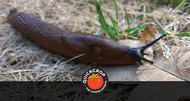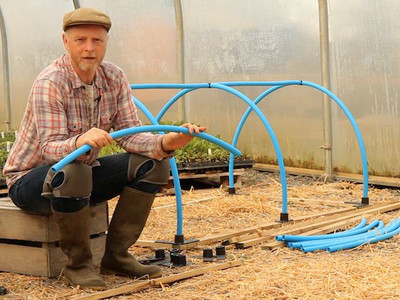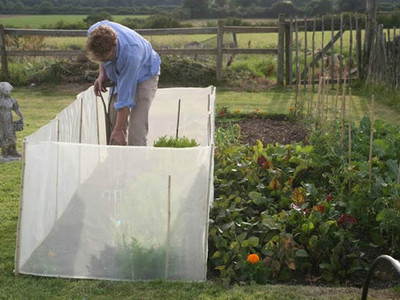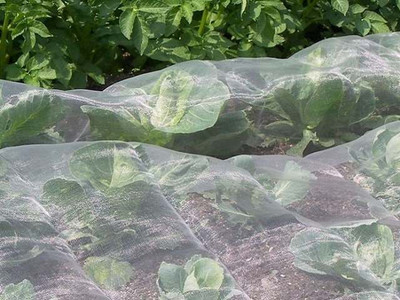Natural Pest Control Methods

It might seem a bit premature talking about pest control in mid March as we have very little in the ground but I think it is worth learning how to avoid some common issues before they arise. As you probably know, I run an organic garden so don't use chemical pest control products as they have a negative impact on the environment.
Natural pest control focuses on maintaining optimum growing conditions for your plants which, in turn, grow strong and healthy and are better able to cope with attack from pests or disease.

It's also about prevention as opposed to cure. Avoidance strategies tend to be more benign, while reacting to an infestation is more likely to require a chemical product. In this article we will be looking at some of these avoidance strategies, as well as looking at some of the kinder products you might need if you do encounter a problem.
Organic gardening has many advantages over a chemical based approach. The crops produced are tastier and more healthy, but the other thing I like about it is it makes us understand nature better. Gaining a little knowledge about our 'enemies' (who are not enemies at all of course, they are just doing what comes naturally to them) will in turn give us a deeper understanding of our garden and of nature's cycles.

Aphid Pest Control
Related ArticleCreating a well fed and healthy soil is the corner stone. After that is is about smart sowing times, crop protection and assisting beneficial insects by including flowers in your planting plans. I include a number of tips below which I hope will help you produce healthy crops without the need for too many expensive cures.
1 - A healthy soil
If there is any secret to green fingers, it is the quality and health of your garden soil. The nutrients released by the life in your soil provide the healthy diet for your plants to thrive and overcome attack from pests and disease. A good soil contains a broad range of nutrients which feed your plants but also strengthen their immune systems.

Feeding your crops with a chemical-based fertilizer is a bit like us surviving on junk food: it is possible but there will be long-term impacts, with a lot more chemicals required to cope with the inevitable problems it will cause. In short, get your soil right and everything else more or less falls into place.
As we said last week, getting your soil right basically involves adding organic matter in the form of garden compost, bought in compost, good quality manure, homegrown green manure, fresh seaweed or seaweed meal. There are other amendments depending on soil type, but bulky rotted organic material is the most important addition bar none.

2 - Sowing and planting times
Smart sowing or planting times can also make a big difference when dealing with pests or disease, as problems will be more prevalent at certain times of the year. By sowing or planting at the right time we can avoid the worst and produce a healthy crop with far less work on our end. I include a few of the most common tactical growing times below:
Potatoes
The fungal disease potato blight is pretty much inevitable in late Summer when your maincrop potatoes are maturing. The only way to control blight is to spray regularly with either copper sulphate or a fungicide, but if (like me) you prefer your potatoes chemical free you probably won't want to do this.

Sarpo Mira Maincrop Potato
View Product
How To Prevent Potato Blight Organically?
There are some excellent blight resistant potatoes on the market (Sarpo Mira, Sarpo Axona, Setanta, Orla) which will help slow the disease, but you can also grow trouble free tubers by choosing your variety and planting time wisely.
Seed potatoes are split into four categories depending on how long they take to mature; they are first earlies (90 days), second earlies (110 days), maincrop (135 days) and late maincrop (160 days). Potato blight is at its worst in late Summer, so if you sow a first or second early variety in mid-March you will be ready to harvest by late June/early July and have your crop lifted by the time the disease hits.

Carrots
Carrots can be a little tricky to grow as they are so particular about soil, but even if you have the perfect plot you are still likely to be troubled by the very common carrot root fly. The fly lays eggs around your young carrots, which then produce grubs that burrow into the roots and spoil the crop.
Avoiding Carrot Root Fly Problems
The pest can be avoided by growing under a cover of fine insect mesh for the lifetime of the crop, but you can also greatly reduce the problem by late sowing.

Micromesh Bulk Roll 1.8m
View ProductThere are 2 generations of carrot root fly in a year: one in Spring and one in early Autumn. By holding off sowing until mid May/early June you will avoid the Spring generation of the root fly, and by harvesting your crop before August you will avoid the Autumn generation and are far more likely to lift perfect smooth roots.
Peas
Peas are a great beginners crop, with big easy to sow seeds and relatively trouble free growth. The two problems you may encounter are pea moths and powdery mildew. I have never had a problem with moths (but they are very common in Southern England), but powdery mildew is very likely in late Summer and early Autumn, especially in dry years.

Fast maturing pea varieties sown in March will have a good chance of cropping before the pea moth lays her eggs (the resulting maggots burrow into the peas), but will also avoid powdery mildew as your peas will have finished before the drier days of late Summer and Autumn when the disease takes hold.
Cabbage
The two main issues with growing any member of the cabbage family are cabbage root fly and cabbage white butterfly.

Cabbage Plant Protection - 20 Cabbage Collars
View Product
Organic Pest Control Strategies for Growing Cabbage
Cabbage root fly maggots will almost certainly kill new seedlings, but a more established plant can normally grow through an attack. The root fly can be controlled by covering the crop with mesh or using cabbage collars around the stem of the plant. Unfortunately it is not something you can avoid by adjusting your planting times.
Cabbage white butterflies are at their worst in late Summer. Unless you cover your crop or are vigilant about removing the yellow eggs from the undersides of the leaves, you can sustain heavy losses from the hungry caterpillars that emerge.

Pointed Spring cabbage is a delicious treat in Spring when the heads mature from an Autumn sowing the previous August. The plant spends most of its life in a relatively pest-free environment, as it puts the the initial growth down in Autumn and stands for the winter, before maturing in April/May when pests are not around.
Early sowings (indoors, to be planted out later) of cabbage, calabrese, cauliflower, turnip and radish will also mature in late Spring before there are too many pests about.

3 - Plant Protection
The introduction of micromesh or enviromesh (they are both the same thing) in recent times has given us a very effective barrier material to keep pests off crops while allowing air, moisture and light to get through.
Mesh is a relatively light material that can be simply draped over crops, but it is best when given some kind of support; this can be a hoop or a frame system that holds the mesh above the foliage of your plants.
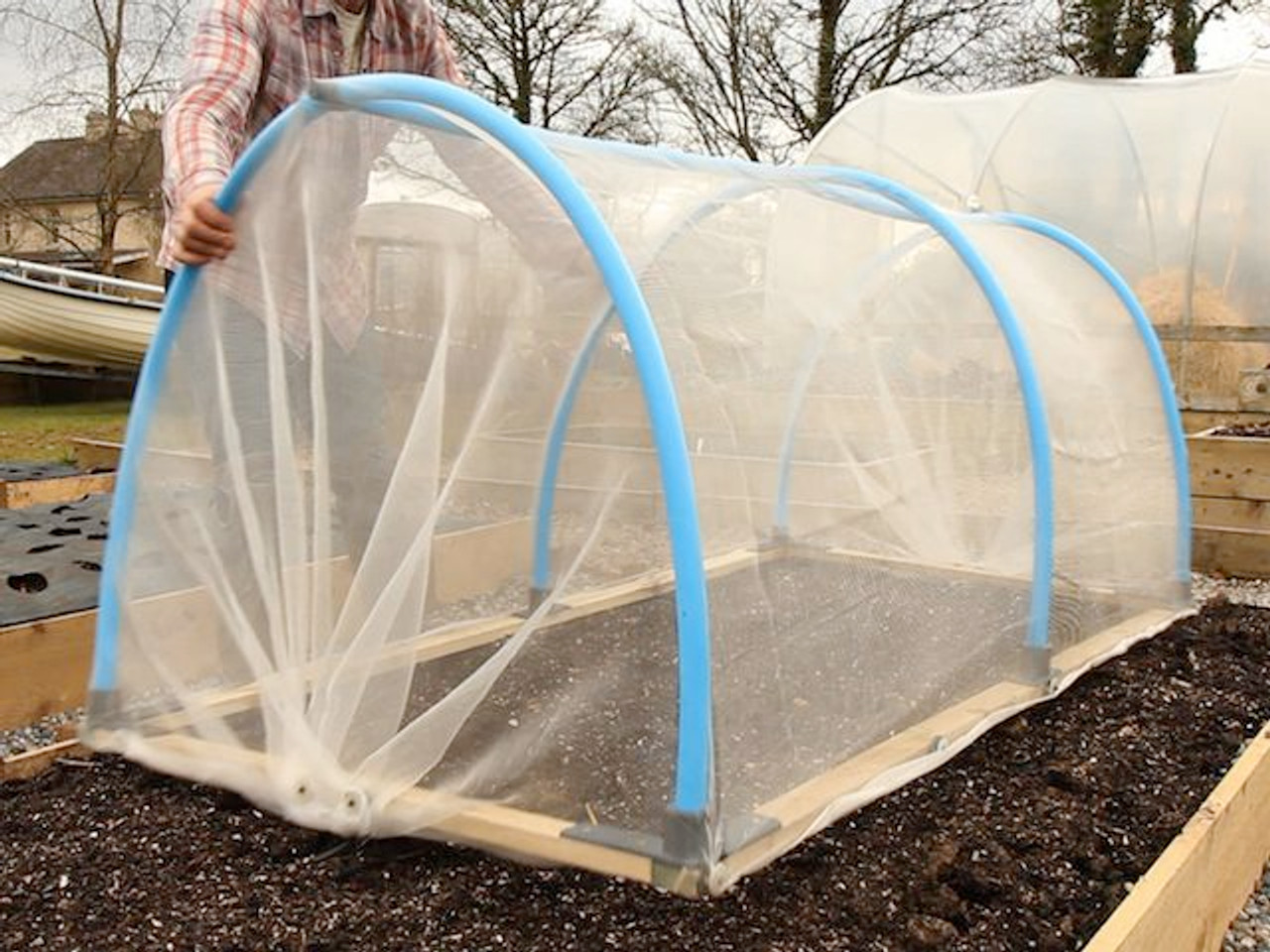
Complete Mini Polytunnel Kit With Mesh Net Cover
View ProductMicromesh is effective against a range of pests but is particularly effective against some of those mentioned above, namely cabbage and carrot root fly and cabbage white butterflies. I use it for both and have found it very successful for cabbage root fly where I use our Quickcrop mini tunnels (pictured above) until the plants are properly established.
Due to the height of crops like flower sprouts, Brussels sprouts and sprouting broccoli, mesh is not really suitable for the later stages of growth where protection against the cabbage white fly is required, but it is ideal for lower growing brassicas like red and green cabbage. An alternative solution here is to spray with the naturally occurring soil bacteria 'bacillus thuringiensis' which is toxic to caterpillars but not to us.

A micromesh cover works like a dream on carrots due to their relatively compact foliage, which can be safely enclosed from seedling stage right through to harvest. Remember to do any weeding or thinning in one session and to get the cover back on quickly, as the smell of the damaged foliage will attract the fly.
Both the mainframe and the Quickcrop mini tunnels are available on our website as component kits and can be arranged to fit a range of bed shapes and sizes. Both systems can also be used with a choice of coverings depending on you requirements and include mesh, fleece or polythene.

4 - Balance your Ecosystem
Keeping your garden ecosystem well balanced will save you a lot of trouble with pests like aphids (greenfly etc...) and hoverfly larvae, as other insects (encouraged by a diverse habitat) will eat them. You will notice, for example, that aphid attacks are more severe early in the season but tend to control themselves as the year progresses when predatory insects 'come on stream'.
It is worth remembering that pests are always present in any garden but if your beneficial insect populations are healthy they will be keeping numbers down to barely noticeable levels.

How To Attract Beneficial Insects
Related ArticlePredatory insects are encouraged by having a wide selection of plants including flowers and (god forbid!) weeds like stinging nettles. If you have room it may be a good idea to 'cultivate' a wild margin to your garden to include nettles and flowering plants for the important habitat they provide.
5 - Tidy Up!
Finally, keep your vegetable garden tidy. Remove any dead or dying foliage (like the yellowing leaves on these Brussels sprouts above), as they will attract and provide a hiding place for slugs as well as harbouring fungal disease.

Slugs and snails will be the most common issue you are likely to have to deal with, but by keeping slug habitats to a minimum you can usually control populations reasonably well. Anything that creates a dark, shady refuge can become a home for slugs: think piles of rocks or timber. Keeping the place neat and tidy will help a lot.
Slugs can be controlled organically using various methods e.g. beer traps that attract and drown slugs. However more pressing circumstances (especially when sowing seeds or planting out new seedlings) may call for more effective solutions, such as slug pellets.

Growing Success Organic Slug Killer
View ProductIf you are using a slug pellet, use a pet and wildlife-friendly (well, not all wildlife, they won't do the slugs much good) type like 'Growing Success' above. Most organic certified pellets have the same active ingredient 'Ferremol', which is toxic to slugs and snails but won't poison birds or animals even if the slug is eaten.
I hope this helps!
I hope you find this information helpful and that it gives you the confidence to try natural methods before reaching for a pesticide. We at Quickcrop are committed to growing in a way that impacts the environment as little as possible and are always on hand to give any practical help or advice we can. We also stock a broad range of natural plant feeds and pest control products to keep you and your garden happy and healthy.
